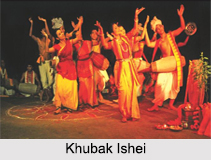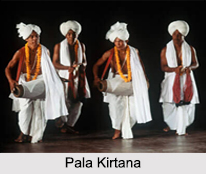 The term Manipuri actually covers a number of dance forms from the region, viz:
The term Manipuri actually covers a number of dance forms from the region, viz:
Rakhual: Also termed as the Gusthalila, this is basicallt a group dance performed by a group of boys, wearing colorful attires and ornaments. Lord Krishna dancing with his mates is the theme of this dance form. The legends from Mahabharata like the demons coming to kill Krishna and almost all the stories from the life of Krishna forms the theme of this Rakhual dance. Colorful dresses like, Churas, koknaams, leitrengs Feichooms or Dhutis and khobols coupled with the stylised form of Dancing ensures the sublimity, subtlety of this dance form.
Khubak Ishei: Khubak Ishei is a type of Clapping song, which is generally performed by the female singers with a male drummer. This form was initiated during the reign of King Churachand Singha. They sing the song of Radhas pang of separation after Krishna left her .
Pala Kirtana: Vaishnava Pala Kirtana using Dhak and Kartal has carved a niche in Manipuri fine arts. The dance is otherwise known as Kartal Cholom or Cymbal Dance. Although starts as a soft and graceful movement, the form, gradually gathers the momentum. It is a group performance of male partners, using cymbals and wearing snow-white ball-shaped large turbans.
Thabol Chongba: This is perhaps the most striking yet seductive dance form. Thabol Chongpa, which literally means the "moon light jump" echoes the serenity and sedulity of the tawny moon amidst the intricate footwork.
As soon as the moon raises over the hills the flute, the drums and the cymbals starts pouring out music. The boys and girls joins hand with the beat of music. They wear no make-up and special costumes.
Other Devotional Forms: The diverse reflections of the song, dance, and martial arts culture that is the innate culture of the Manipuri people are as follows:
1. Udukhol: Krishnas Valya Lila and Vatsalya Ras is enacted through this dance and devotional music.
2. Basak: A kind of Sangkirtan for males and females alike, where the theme is derived from Basak Sajya, preparation of a seat for Sri Krishana and Sri Radhika and her maids with flowers.
3. Gouralila: Performed by boys of the age group of 8 and 10 years, representing Sri Chaitanyas lila such as meeting the Kesav Vharati, saving jogai - madhai, etc.
 4. Thang Ta: Martial arts by the Manipuri Meitheis, the dance with the use of spear and sword.
4. Thang Ta: Martial arts by the Manipuri Meitheis, the dance with the use of spear and sword.
5. Nupa Pala: Also known as Kartal Cholom or Cymbal Dance, is a characteristic of the Manipuri style of dance and music.
6. Dhop Kirtan: A kind of kirtan style, which is devoid of movements, must be held in connection of Durga Puja, Jhulan Jatra, Mera and Kartika festival.
7. Ipom: A form of entertainment where two or three Jatra personalities take part and discuss something. Sumanglila is the most popular form.
8. Gostha Lila: Another dance that has stemmed from the Vishnu Cult is the Goshta Lila, also known as the Sanshenba. The performers are generally young boys in the age group of four to five years. Stories detailing Krishnas childhood pranks are performed in Goshta Lila. The rendering of these stories combines divine inspiration with a lively spirit of fun.
9. Ballet Or Drama: This is also a colorful part of Manipuri Culture. It is theatre and Jatra that have the honor of being the chief cultural and artistic forms during the past few decades. There are dance dramas like Nimai-Sonyas, Sita-Horon, Nouka-Bilash, Savitri-Styaban, Chandrajini, Harishchandra, Nal Domoyonti, Moirang Parva, Ramayana, Kurukhetra, Lankakanda, Kamsabadha, etc., which are wonderful and beautiful. The jatra is like an opera generally performed in the open in a circle surrounded by audiences, stage or screen. The famous ballet Numit speaks the story of two suns, having rhythm, expression and lyric.